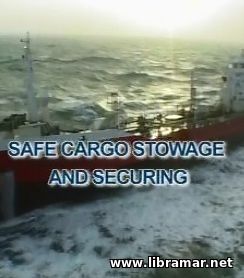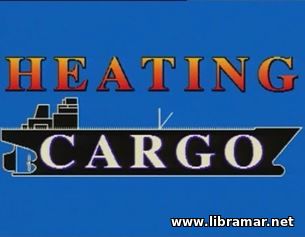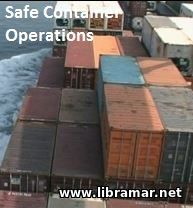 Everyone in the shipping industry is well aware of the fact that inadequate or improper securing and stowage of the cargo can be a really major problem. This may eventually put human lives under risk and may also result in the damage to the vessel, environment and cargo. In turn, lost or damaged cargo will lead to the insurance claims.
However, most of the cargo losses could be avoided provided that greater care is taken at the time or loading and securing cargo. The present training video is intended to stress how important it is to ensure that all cargo has been stowed and secured properly before the vessel sets out to sea. In many ports of the world this is done by stevedores; however, the ship's officers shall have a clear understanding of all methods and techniques to be used and also know the reasoning behind these methods and techniques.
This training video also emphasizes the important role played by the IMO Code and Guidelines relating to this topic. They shall be referred to as the basic guidelines for the seafarers to securing all types of cargo. The authors of the video are looking at the different forces that commonly act to the cargo in connection with the movement of the vessel and different stowage and securing methods...
 The main learning objective of this short video is to examine the contents of the IMDG Code together with its Supplement leading to a due understanding of their practical application.
The content is mainly based on 2008 edition of the Code incorporating Amdt. 34-08 and Supplement. The IMDG Code is an internationally recognized official agreement governing the maritime transportation of various dangerous cargoes.
Many sections of the subject Code are considered applicable to people working ashore and cover the documentation, cargo packaging and handling and other relevant activities.
The senior officers of the ships engaged in transportation of the dangerous goods by sea as well as the management staff supporting them from the shore, shall have a thorough understanding of the provisions of the Code since they will be obliged to follow the instructions provided in the pages of this regulatory document during cargo loading and discharge, proper arrangements of the activities, paperwork involved and other aspects.
The basic knowledge of the content of the Code will help make sure that the seafarers will perform all assigned duties better. Note that the majority of the problems associated with transportation of the dangerous cargoes are actually not the fault of the crew members...
 According to the official statistics, the greater part of cargo voyages ends successfully, but research by UK P&I Club reveals that, unfortunately, an increasing number do not. Across the industry, cargo loss or damage accounts for one out of four major insurance payouts. The gas is the world's favorite fuel, and keeping up with demand requires more and more ships, and more and more crews.
So, how will gas shipping meet the challenge of change? This official video release prepared by the UK P&I Club sheds some light on the most important aspects of transporting the gas cargo by sea. The authors are mainly focusing on the most frequently happening gas cargo claims and their causes; they are trying to find out how to avoid them. As it is the case with any other publication from this team, the video has the ultimate aim to increase the awareness of the people related to the causes of the common P&I claims for the damage and loss of transported cargo.
That is why we would consider these publications, and Gas Cargo Claims, in particular, the useful training material for all students and professionals, including ship owners, crew members and everyone involved in marine transportation of gas.
 A moment when a vessel arrives in a port is deservedly considered a crucial time. First of all, the master and crew members shall get alongside safely. Once this task has been completed, the real work commences. It shall be understood that the relationship existing between the ship and the shore is critically important and fundamental, since is the one of the key items determining the safe operation of all activities at the jetty.
All people on board ship shall have a clear understanding and confidence in the shore offices, and the shore officers, equally, must have a sound understanding and knowledge of the work that ship people do. Without that, unfortunately, it is next to impossible to ensure that the operation has been set on a proper professional basis and if the ship shore-safety checklist is not followed, then you are facing a disaster. Being very informative, this training video is recommended to be watched by all crew members and ship officers as well as by the shore support personnel.
 Methanol is is very wide use everywhere in the world as an effective chemical commodity and fuel. This video is the information source for methanol. It has been originally developed with the aim to promote the maximum safe handling of methanol and minimization of health-related risks to employees, work places, environment, and the community.
It is supplementing the Methanol Safe Handling Manual which is also readily available at our website. The key points covered in this video are the fundamental physical properties of methanol, the key risks associated with handling of methanol, ways of minimization of the exposure to methanol, fire, release of the methanol into the environment, and what shall be done in case of an event involving the methanol.
 Hatch covers are considered a major cause of shipboard accidents causing serious injuries to the crew members and dock personnel as well as to the cargoes transported by the vessel. In some cases when the operational/maintenance procedures are not duly followed this may even lead to the loss of ships. These dangers have been highlighted by the several fatal accidents involving hatch covers deservedly treated as hazardous equipment.
Since the modern hatch covers are very complex and sophisticated, many of them have been covered within this training. Note that the training set consists of this video and associated booklet. All of the associated peripheral items including rubber packing and bearing pads, compression bars and hatch cover cleats have been illustrated and clearly explained; the authors of this training video have emphasized how these items contribute to the overall tightness of the hatch cover assembly and preserve cargo from ingress of water.
The content of the video features detailed professional analysis of the typical problems together with the recommendations for the routine inspections of the hatch covers and corrective actions where necessary. This training set will definitely help in increasing awareness of the crew members and provide them all with the required knowledge.
 This video is one in the series dealing with cargo operations on board an oil tanker and supplements the two video lessons addressing the Tank Cleaning and Pumping Cargo. Here we will be dealing with the task of heating the cargo in order to maintain its temperature. The video will demonstrate the working principle of the cargo heating systems commonly utilized on board oil tanker ships.
We know that heating cargo is necessary operations and that is why proper understanding of the operational matters will eventually result in effective cargo heating while failure to understand the system can have negative consequences. Even though the tankers of today seriously differ in size, the basic of their design and construction, including arrangement of the tanks, namely cargo, slop and ballast tanks, remains more or less same. The heating of the cargo is mainly done by using the cargo heating coils installed in each of the cargo and slop tanks.
All personnel involved in cargo operations on board any tanker shall familiarize themselves with the tank arrangement and position of the coils as well as all relevant technical characteristics as necessary, before they start their work. This video, when watched with the other two lessons, will give a good introduction to the subject.
 Containerization has revolutionized the shipping of cargo. It is estimated that some eighty million containers make over two hundred million trips a year, carrying about ninety percent of today’s bulk cargoes. It means more than four hundred million container handling operations done in a year’s time in nearly all ports around the planet. As for the ships that carry them, they are now capable of transporting thousands of containers.
However, there are many issues involved in marine transportation of the containerized cargo, and also the competition in the field is great. In turn, this means that already tight schedules are becoming even tighter, bigger ships carrying more and more containers on board; however, there are now fewer people on board to deal with handling those thousands of containers.
The nature of the container business is very complicated, for example in many cases the stowage plan of the vessel considers loading in one continent and discharging in another part of the world. There are more and more people in the shipping process and an increasing lack of familiarity with the process itself.
These days, the reality is that the ships cannot always be sure exactly what cargo they are carrying or how it is placed and secured within the container. Every year there are containers badly stowed, containers damaged and leaking, lost overboard and even fires and explosions; and, the worst of all, there is loss of lives and damage to the marine environment…
|







